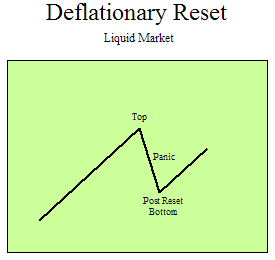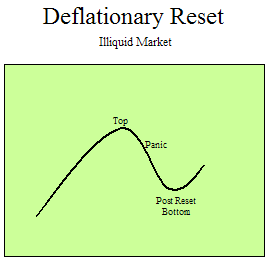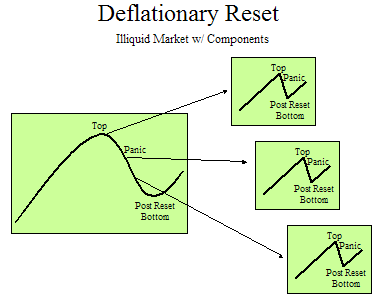Until now, we’ve been exploring what’s been happening in our economy since the financial crisis began. To summarize, we are currently in a deflationary cascade brought about by a financial panic that started when credit markets around the world realized that much of the debt outstanding was not likely to ever be paid back. This is now showing up in deflating prices in any asset class that depends on debt financing, including residential and commercial real estate, and small businesses. In today’s posting, we’ll explore some strategies for benefiting from this chaos.
Rule #1:Â Buy Low, After a Reactionary Price Reset
One unique feature of the switch from inflation to deflation (optimism to pessimism, greed to fear, etc.) is this change in people’s sentiment occurs very quickly, often in a matter of days or weeks. And once it does, the reaction is usually excessive, moving prices from an overvalued position, past the point of equilibrium to an undervalued position. Then, once things settle down, the undervalued position will often migrate once again toward equilibrium. For an example of this pattern, check out this graph of the Dow Jones Industrial stock prices since October 2008.
In a perfect world, investors could profit from this pattern by selling just before a panic, then buying just after the reaction to the panic. Unfortunately, it is very hard to predict when these changes in sentiment will occur. Even the market prognosticators who correctly predicted the housing collapse, had difficulty predicted *when* it would occur.
While this may not be possible for highly liquid markets, it actually becomes easier for illiquid markets. For an example of this, check out this graph of the decline in Residential and Commercial real estate prices. You can see how these two versions of deflation play out in the following graphs:
 |
 |
It’s important to remember that the aggregate price in an illiquid market, is made up of many individual asset prices that reset at irregular intervals over the course of a correction. This can be seen in the following graph:

Armed with this knowledge, it becomes much easier to define a strategy to profit from the turbulence. Today, we know that commercial real estate and small businesses are deflating in value. We also know that, because of long term obligations, these prices are illiquid, and not able to reset on a fluid basis. When they do finally reset, they will often be sold for less than their equilibrium value, presenting an opportunity for profit.
So, to sum up rule #1, find an asset you are interested in, and buy it as soon as the seller capitulates to the new realities, as outlined in “Personal Experience of Deflation”:
- Seller lowers the price beneath their debt, and takes a loss on the sale.
- Seller offers the asset for less than they owe, and gets the bank to take a “short sale” on the property.
- Seller gives the asset back to the bank as a “deed in lieu of foreclosure,” then the bank sells it at the market price and takes the loss.
- The seller defaults on their payment, then the bank takes it back through a foreclosure and sells it at a discount.
In future postings, we’ll explore other rules for buying deflating assets at a profit. But next, we’ll start to explore the changing nature of employment in the Great Recession. As always, comments welcome. Until next time …
Tranzitioning.com is a blog by Jay Fenello, principal and founder of BizPlacements.com, an Atlanta-based
Business Brokerage and Placement firm that helps people buy and sell small businesses and franchises.
